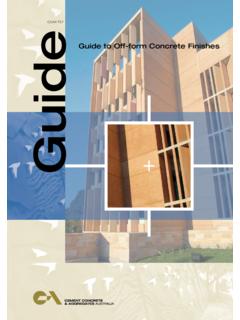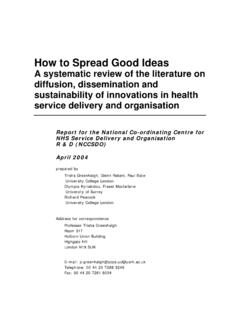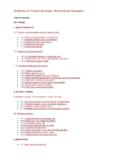Transcription of Technical Brief No 2 - International Labour …
1 ASIST Information ServiceTechnical Brief No 2 Productivity Normsfor Labour - based constructionInternational Labour OrganisationADVISORY SUPPORT, INFORMATION SERVICES, AND TRAINING (ASIST)Nairobi, KenyaThe Employment-Intensive Programme (EIP) is a sub-programme within theDevelopment Policies Department (POLDEV) of the ILO. Its objective is to promotethe use of local resource based technologies in infrastructure works in developingcountries and to strengthen their capacity to apply such is a sub-regional programme under the EIP, one of whose objectives is toachieve an improved effectiveness of road construction, rehabilitation andmaintenance in Sub-Saharan Africa and thereby promote employment and incomegeneration in the rural and urban aim of ASIST Technical Briefs is to spread knowledge about Labour -basedtechnology and management amongst policy makers, planners, designers,implementers and Normsfor Labour - based constructionFirst editionThis publication was developed by theASIST Technical team in Harare, Zimbabwe,and Nairobi, by David Stiedl.
2 From originalmaterial collected and collated byUlf Brudefors and Mike and layout by David Labour OrganisationAdvisory Support, Information Services, and Training (ASIST)Nairobi, Kenya2 ILO/ASIST Technical Brief No. 2: Productivity NormsCopyright International Labour organisation 1998 Publications of the International Labour organisation enjoy copyright under Protocol 2of the Universal Copyright Convention. Nevertheless, short excerpts from them may bereproduced without authorisation, on condition that the source is indicated. For rightsof reproduction, adaptation or translation, application should be made to theILO/ASIST Information Service, PO Box 60598, Nairobi, Kenya, or to ILO PublicationsBranch (Rights and Permissions), International Labour Office, CH-1211 Geneva 22,Switzerland.
3 Both ASIST and the International Labour Office welcome Brief No. 2: Productivity norms for Labour - based constructionFirst published 1998 Produced by ASIST Information Servicewith financial support from theSwiss Agency for Development and Cooperation (SDC)Set in Arial and Century Schoolbook typefaceson an Hewlett-Packard LaserJet 4000TN printerusing Microsoft Word for Windows publications can be obtained direct from ASIST Information Service,PO Box 60598, Nairobi, Kenya, Tel +254-2-572555, Fax +254-2-566234,email: Website: designations employed in ILO publications, which are in conformity with UnitedNations practice, and the presentation of material therein, do not imply the expressionof any opinion whatsoever on the part of the International Labour Office concerning thelegal status of any country, area or territory or of its authorities, or concerning thedelimitation of its frontiers.
4 The responsibility for opinions expressed in signedarticles, studies and other contributions rests solely with their authors, andpublication does not constitute an endorsement by the International Labour Office ofthe opinions expressed in them. Reference to names of firms and commercial productsand processes does not imply their endorsement by the International Labour Office,and any failure to mention a particular firm, commercial product or process is not asign of is not an official ILO documentILO/ASIST Technical Brief No. 2: Productivity Norms3 ContentsList of for Labour - based , unloading and , UNLOADING AND EXAMPLE OF COMBINED affecting AND EXPERIENCE OF THE OF THE AND EQUIPMENT SPECIFICATION AND 1: FOR PRODUCTIVITY 2: Country productivity DATA FOR SITE CLEARING DATA FOR EXCAVATION DATA FOR HAULAGE DATA FOR LOADING, UNLOADING AND DATA FOR COMPACTION DATA FOR CULVERT LAYING 3: Labour productivities in constructionworks a historical Technical Brief No.
5 2: Productivity NormsList of TablesTable 1: Bush clearing 2: Soil excavation 3: Haulage equipment 4: Tools for loading, unloading and 5: Tools and equipment for 6: Tools for culvert 7: Site clearing norms country 8: Site clearing norms recommended 9: Excavation norms country 10: Excavation norms recommended 11: Wheelbarrow haulage norms country 12: Wheelbarrow haulage norms 13: Typical haulage rates for manually 14: Loading, unloading and spreading norms country 15: Loading, unloading and spreading norms recommended 16: Compaction norms country data andrecommended 17: Culvert laying norms country 18: Culvert laying norms recommended 19: Typical equipment / Labour combinations 20: Summary of recommended 21: Observations on worker 22: Average worker input for Technical Brief No.
6 2: Productivity Norms5 AcknowledgementsThis document is part of an occasional series of technicalbriefs produced by ILO/ASIST to synthesise and summarisetechnical information on important aspects of original research and information acquisition is the workof Mike Shone and Ulf Brudefors, who also produced asubstantive first draft. David Stiedl was responsible forrevising and editing this draft to take account of commentsreceived from a number of key practitioners and senior also wish to thank Gary Taylor for the historicalperspective of Labour productivities in construction works(Annex 3), and the many project staff who took the time toanswer the detailed questionnaires, thus ensuring thedocument its practical Technical Brief No. 2: Productivity NormsAbbreviationsASISTA dvisory Support, Information Services andTraining for Labour - based technologyCTPC onstruction Technology PaperDFRD epartment of Feeder RoadsELHUE xcavate, Load, Haul, UnloadKIHABTK enya Institute of Highways and BuildingTechnologyKTCK isii Training CentreLCUL abour Construction UnitLBDUL abour- based Development UnitMARTM anagement of Appropriate RoadworksTechnologyMRPM inor Road ProgrammeTRLT ransport Research LaboratoryRARPR ural Access Road ProgrammeUSDU nited States DollarsWBWorld BankILO/ASIST Technical Brief No.
7 2: Productivity Norms71 IntroductionAll civil engineering projects rely on the productivity of theirequipment and workers to achieve good results. Majorcapital works projects with a high element of equipment canestimate with some accuracy how much and what kind ofequipment will be required for the type of work manuals such as the Caterpillar PerformanceHandbook provide work outputs for most common equipmenttypes ( based on the assumption that they are properlyutilised), and these figures form the basis of all cost and timeestimates. Individual Labour productivity, while important toensure equipment is utilised effectively, will have a minorimpact on overall costs and projects however are almost entirelydependent on the productivity of Labour . Provided theworkers are properly organised and supplied with thecorrect handtools, they will be able to carry out most of theactivities usually done by earthmoving machinery.
8 However,it is essential to have realistic estimates of expected labourproductivity in order to plan and carry out Labour -basedwork first action of any planning engineer on a Labour -basedproject should be to determine the quantities and type ofwork to be carried out. The engineer should then divide thiswork into activities that can be carried out by individuals orgroups of workers, and then, by applying work norms,determine the required Labour force and the duration of theproject. Choosing the correct work norm is the most criticalpart of this a very simple example, one kilometre of drainage ditch tobe excavated for a pipeline could be considered as only oneactivity, excavation. If it is known that the averageamount of material to be excavated is 2m in volume permetre length of ditch, and the productivity norm of theworkers is set at 3m per day, then the project could becompleted in one day with 667 workers.
9 At the otherextreme, it would take about three years with one worker. Amore typical set-up would be a group of 48 workers deployedover 14 critical figure is the productivity norm. Workers arecommonly set tasks in Labour - based works that equal thesenorms. If the task is underestimated by 30 per cent, 2m aday for excavation rather than 3m3 in the example above, thedirect cost of the project will increase by 30 per , if the tasks are overestimated, then much of theworkforce will not be able to meet its targets and there willbe considerable disruption and discontent on the correct productivity is probably the mostimportant decision for the engineer. If the physicalquantities are wrongly estimated this can be corrected on re-measurement. If the number of people recruited areinsufficient this can also be easily rectified; but altering the8 ILO/ASIST Technical Brief No.
10 2: Productivity Normsnorms significantly at a later stage involves convincingworkers to do more work for the same money, which can bevery difficult, and not conducive to success in a labourdependent , there has been a lot of work done ondetermining realistic work norms for different activities indifferent situations. It should therefore be possible for aplanning engineer to draw upon that experience at the startof any project, with the confidence that it is the correct orderof magnitude and that it can be fine-tuned as workprogresses. Unfortunately, much of this data is difficult tofind, and often relates to very particular circumstances, withunique project assumptions. It can therefore be quitemisleading to simply apply such norms without a fullappreciation of the project and project organisation fromwhere the data has been involved in project design and monitoring oflabour- based programmes for a decade, and has access toproject reports and data from projects all over the world.
















